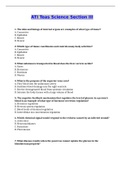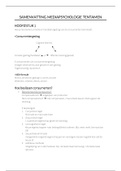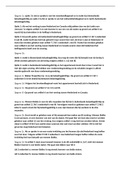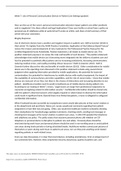1. General notions
Competition:
Where two suppliers both serve customers in the market, they compete with each
other.
Rivalry between companies is to be protected as it stands for lower prices and
increased quality and innovation
If two undertakings do not compete: higher prices, lower quality, less innovation.
Exclusivity agreements Foreclosure of competitors and creation of dominant
undertakings.
How does one affect competition?
o Coordinated behavior – agreements and collusions, unilateral practices by powerful
companies.
o Structural changes – mergers.
- EU Competition law: national laws are subordinated to EU law when the practices they
govern affect trade between the states. EU law prevails in the case of discrepancy between
national law and Union law.
o Objectives of competition law:
protecting consumers: companies should not collude at the expense of
consumers [Art. 101 TFEU]
Protecting market integration: anti-competitive agreement may restore
national divisions in trade.
Economic efficiency and consumer welfare: Art. 101(3) exceptions.
Allocative efficiency: consumers obtain maximum welfare (lower
prices etc.)
Productive efficiency: production is made at the lowest cost possible
Dynamic efficiency: short-term and long-term concerns are
optimally balanced (e.g., innovation is protected)
o Two rationales: economic freedom & economic integration (single market)
o Two main provisions:
Art. 101 TFEU: anti-competitive collusions.
Art. 102 TFEU: abusive behaviour. – the fact that an undertaking has a
dominant position is not illegal, but it is illegal to abuse of it.
(+ Art. 106 TFEU: undertakings with exclusive or special rights)
o Beneficiaries: small companies (not dominant) and customers. - Competition law has
distributive effects among and within producers, consumers and the society as a
whole.
o Offenders: undertakings; individuals (in certain MS); MS.
o Sources:
EU law:
TFEU; Secondary law; Soft law; Case law; Individual decisions
National law:
The same + Code de commerce; Soft law; Case law; Individual
decisions
General Map of EU competition law:
Addressed to undertakings:
Control of behaviour:
Articles 101 TFUE: coordinated conduct (not necessarily with market power)
1
, Article 102 TFEU: unilateral conduct (market power always needed)
Control of structure: Merger control (Regulation No 139/2004)
Addressed to Member States
General obligation not to deprive competition rules of their effet utile
Rules on State Aid
General map of French Competition Law:
Rules addressed to undertakings:
Control of behaviour: Articles L. 420‐1 and 420 ‐2 Code de commerce
Control of structure: Merger control (Articles L. 430 ‐1 to L. 430 ‐10 Code de
commerce)
Scope of the application:
Undertaking: “every entity engaged in an economic activity regardless of the legal status of
the entity and the way it is financed”
Economic activity: any activity consisting in offering goods and services in a given
market
Legal form does not matter.
Does not need to be for profit.
Exclusions:
Social sector: sickness funds; collective agreements; public activities of
general interest.
Functional definition the same entity can be an undertaking for
some activities and not for others
Investors – depending on the degree of involvement.
Excluded sectors: agriculture (Art. 42 TFEU).
Associations of undertakings:
o The corporate limits of undertakings - Case C-97/08 Azko Nobel and Others: what
matters is the economic unit the group of companies that do not decide
independently upon their conduct in the market.
A subsidiary is not a single entity with the parent if the parent does not
exercise decisive influence over its commercial policy.
2
, If a subsidiary commits an infringement, the parent will be liable if it has
decisive influence.
If D commits an infringement:
Competition authorities will try to apply the infringement to all
companies (joint and several liability)
C and B will be liable (95%-100% shares – presumption arises)
A (only 5% in C) – unlikely liable;
An anti-competitive agreement will not be caught if it is between the entities of the
same group – reason: entities of the same economic unit act together on the market
(e.g., Apple can set the price with Apple Stores but not with non-Apple resellers)
Substantive scope:
Two conditions:
Trade between MS is affected:
If trade is not affected: national law applies
If trade is affected: EU law and national law apply (primacy of EU law;
conflicts between legal regimes prevented by Regulation No 1/2003)
Assessment: Consten & Grunding: when an agreement covers the whole
territory of a MS this affects trade between MS (makes entry in national
market more difficult).
Potential effect is enough.
Effect on competition in the internal market :
Two alternative tests: (i) implementation test; (ii) qualified effects test
(immediate and substantive effect)
Broad territorial reach: if there is an effect in the EU market, there is
jurisdiction.
Basic notions:
Market:
Two dimensions: product scope and territory in which competition is analyzed:
Product market: products that are interchangeable or substitutable.
Stage 1: Demand substitutability: product characteristics, intended
use, price.
Stage 2: Offer substitutability: possibility of product switch.
Defining the product market allows for calculation of market shares
and assessment of barriers to entry.
3
, Main Q: what would happen in case of a small, non-transitory
increase in price? Would consumers switch from product A to
product B? Would producers of product A start producing product
B?
Geographic market: area “in which the conditions of competition are
sufficiently homogenous, and which can be distinguished from neighboring
areas because the conditions of competition are appreciably different in
those areas”
Need to define a product within a given geography (analyze
consumer options for the same product and consider transport
costs)
** egregious infringements do not need market definitions (cartels)
Complex chains of supply:
First thing to do: identify the chain of supply: you cannot determine how actors
position themselves in the market if the chain of supply is not firstly understood
For each level of the chain, understand product and geographic markets
Example:
A. Fisheries B. tuna can manufacturers C. supermarkets consumers
A, B and C: not the same markets.
Market power: market power exists where a firm has the ability profitably to raise prices
over a period of time.
Not an exclusive, but an essential part of competitive analysis.
Acquiring market power may be due to fair competition: not illegal per se.
High market power increases the risk of anticompetitive activities (collusion, merger,
abuse to increase market power)
Not relevant only in cases of infringement by object.
Market shares: 40% is a significant share – but: merely a first step in the analysis –
they do not provide an insight of potential competitors. – Always analyze barriers to
entry/innovation/potential competition
Dynamic analysis is needed: market shares change – may signal past power.
Assessment of market power:
The market position of the dominant undertaking and its competitors
Threat of future expansion by actual competitors or entry by potential
competitors
Countervailing buyer power: constraints imposed by the bargaining strength
of the undertaking’s customers.
ARTICLE 101 TFEU
Article 101(1) TFEU: Prohibition
“1. The following shall be prohibited as incompatible with the internal market: all agreements
between undertakings, decisions by associations of undertakings and concerted
practices which may affect trade between Member States and which have as their object or effect
the prevention, restriction or distortion of competition within the internal market”
(a) directly or indirectly fix purchase or selling prices or any other trading conditions;
(b) limit or control production, markets, technical development, or investment;
(c) share markets or sources of supply;
4









